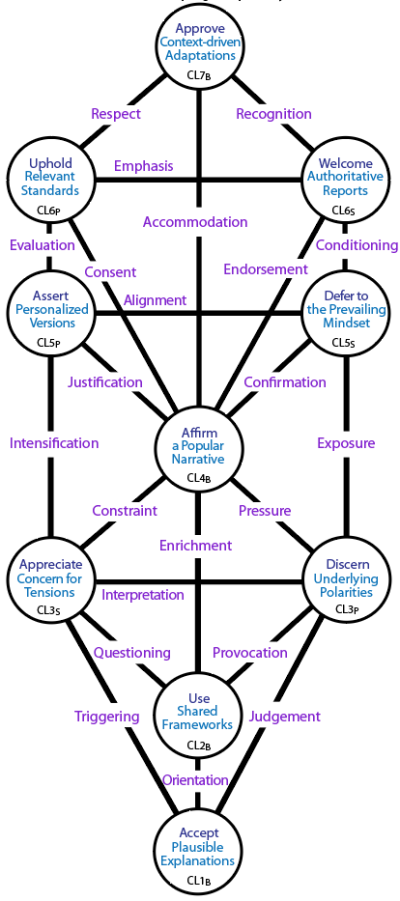Review: Determinants of Fitting In
Fitness as a Primal Need

Fitting in brings the dynamic duality of personal v social that pervades every dynamic Tree pattern into sharper focus. No functioning of any sort can take places without influence from the social dimension and social pressures.
Fitting in can be a survival issue. However, for those who feel they do not or cannot fit in, managing communications and self-control over actions can be protective. Vagueness and ambiguity are commonly used to this end.
What was not clear or insufficiently emphasized prior to this investigation is the way that fitting in is channeled through and . These activities are naturally dependent on the and it is notable that the method in general use in society is . This type of language does not demand precision or conviction, but merely consensus with an implicit feeling that mutual understanding is occurring regardless of whether this is the case. The language of familiars is which is even looser in content and form.
In thinking of fitting in, the effect of differences in value systems, ideologies and conventions come to mind. These all belong in the , specifically: . These relate to living in general and the need for coexistence: see Ch.4 and Ch.9 in Working with Values. Within any particular group, these differences are commonly irrelevant if the purpose of the group and its shared reality are respected by all members.
A bigoted or segregationist approach can be exclusionary, but the issue of fitting in does not exist in such cases. You cannot fit in where you are told that you do not belong.
A person may be rejected from a group for rank incivility, rudeness or breaches of etiquette. If this is accidental, then an apology usually suffices. If it is deliberate then the individual is deliberately getting themselves rejected.
Psycho-Social Pressures
It has been established (here) that the Spiral reveals how the next higher Root level and Domain influences the current Spiral Domain. In this case, the next higher Domain is .
Cycle-1 modes generate the lower 4 Centres of the Tree and contribute their psychosocial pressures. As a group, they are dominated by acceptability, which is the overall psychosocial pressure of the .
These Centres control any (the Domain Field). Going along with change: i.e. level-1 performance is the concrete demand but all other Centres call for transcendence. Using shared frameworks (CL2) calls for selflessness, appreciating polarization (CL3) calls for understanding, and genuinely affirming a narrative (CL4) calls for autonomy.
Cycle-2 modes generate the upper 3 Centres of the Tree and contribute their psychosocial pressures. These are dominated by a pressure for well-being, which is generated by the .
The effect is to make acceptability comfortable: and these pressures are actualizing in nature. Being acceptably practical (CL7), knowing reassuring standards (CL6) are applied, and feeling certain about a version(CL5), all make a person comfortable about fitting-in—or lead them to refuse to fit in.
► See next topic for a more elaborate Tree pattern including the above findings.
Further Frameworks
This Satellite is completed for now.
However, completing the investigation of calls for the discovery and development of several more frameworks.
In the , the structural hierarchy containing the components for needs formulation. This would then be expected to generate a framework for a , which is the field for any Definitive Stage (PH3K). Provisional formulations are in the Taxonomy Notes.
In the , the Spiral-derived structural hierarchy is expected to contain components for , which in turn generates a framework currently named . Provisional formulations are in the Taxonomy Notes.
Finally there are, with each Arena requiring a set of frameworks. Provisional formulations, yet to be developed, will initially be posted in the Taxonomy Notes.
Originally posted: 1-May-2025. Last amended: 5-Oct-2025.